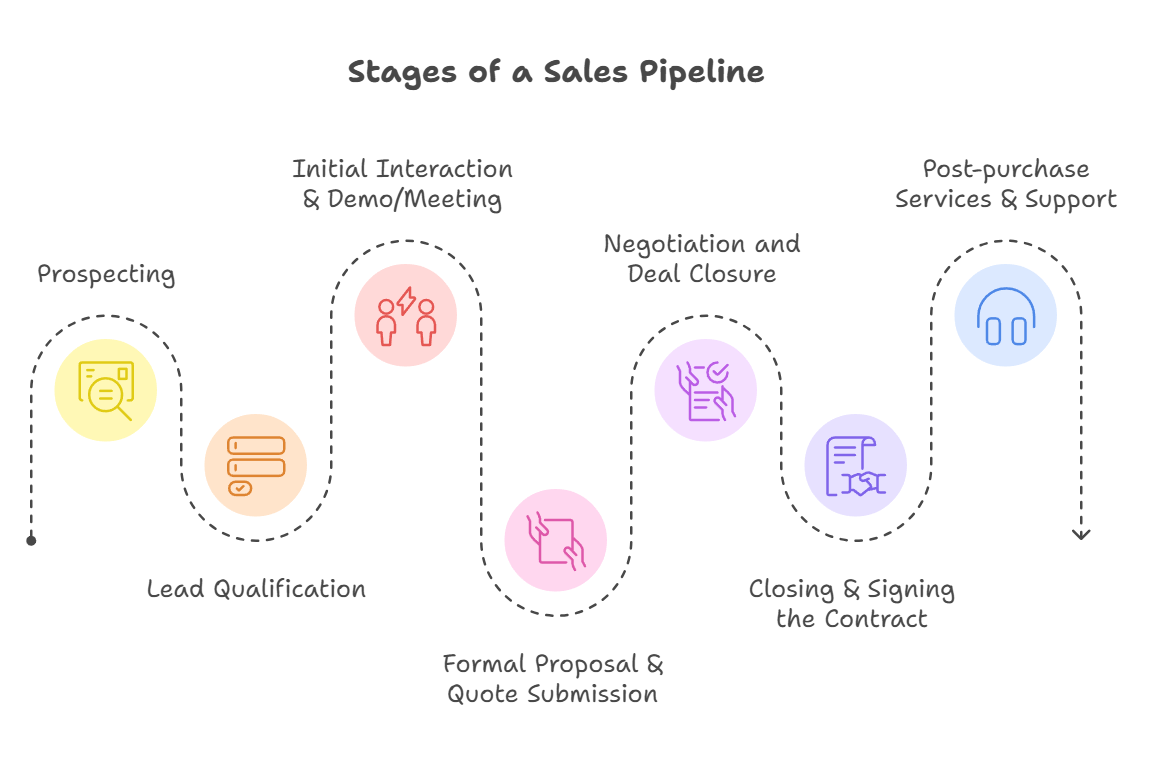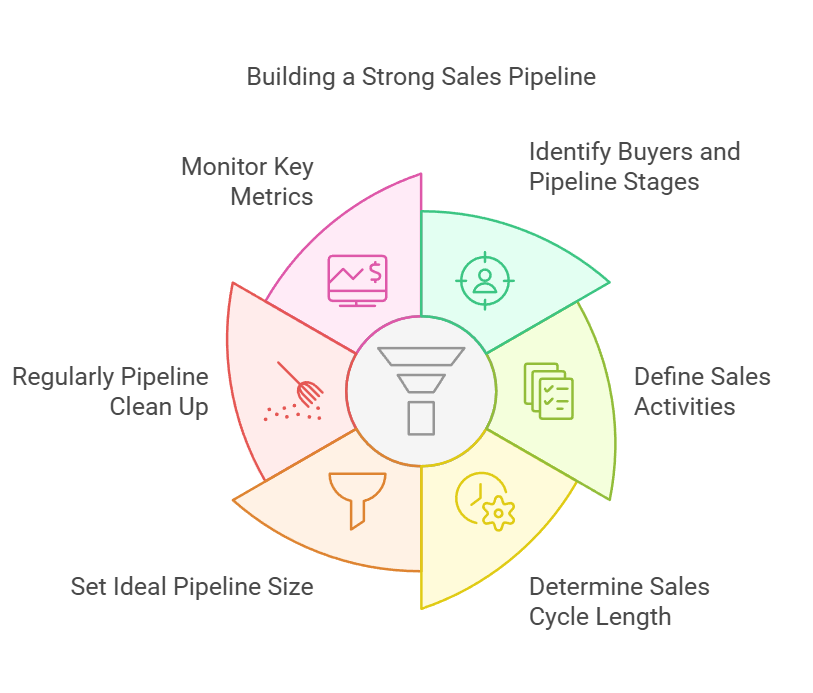7 Stages of a Sales Pipeline: How to Build and Manage Them Effectively
Master the sales pipeline with structured stages like prospecting and closing to boost sales.

“Efficiency is doing things right. Effectiveness is doing the right things.” - Peter Drucker
In the realm of sales, effectiveness is the key that guides us towards success. A well-structured sales pipeline is the embodiment of that efficiency, sailing you through the intricate process of lead generation and deal closure with finesse.
It's important to differentiate this from a sales funnel, which focuses on the customer's journey from initial awareness to final purchase, while the pipeline emphasizes the business’s processes for converting leads into customers.
Imagine your sales process as a well-oiled machine, converting high-quality leads into loyal customers with ease. Companies with optimized sales pipelines report 28% higher revenue growth compared to those with poorly managed pipelines.
To achieve sales mastery, you must understand and optimize the seven critical stages of your pipeline. From prospecting to closing, each stage plays a crucial role in your success.
In this article, we’ll dive into these stages, arming you with best practices and proven strategies to optimize each one for maximum impact. You’ll learn how to generate high-quality leads, nurture them through the pipeline, and close deals like a pro.
Get ready to take your sales game to the next level. Start with Alisha-AI SDR, Book your Demo Today!
What is a Sales Pipeline?
A sales pipeline is a visual representation of the customer’s journey from initial contact to closing the deal, helping sales teams track and manage prospects effectively. This strategic roadmap guides your team towards success, with each stage representing a milestone in the buyer’s journey, ensuring no opportunities are missed.
A sales pipeline focuses on the business perspective and specific actions needed to convert leads into customers, emphasizing a structured approach to managing sales processes.
A well-structured sales pipeline is more than just a visual aid – it’s a strategic asset for optimizing sales operations and maintaining a competitive edge. By analyzing pipeline data, you can identify bottlenecks, forecast sales accurately, and allocate resources effectively, ultimately driving growth and success.
Moreover, a sales pipeline fosters collaboration and transparency within your team. When everyone has access to the same information, it creates a culture of accountability and enables reps to work together towards common goals.
In today’s fast-paced business landscape, having a robust sales pipeline is essential. By leveraging its power, your team can stay focused on high-priority opportunities, personalize their approach, and consistently hit sales targets.
Stages of a Sales Pipeline
The B2B sales pipeline typically consists of 7 stages, reflecting the complexity of the product or service. These stages guide the journey from initial prospecting to closing deals, encompassing activities like lead nurturing and objection handling.
1. Prospecting
Sales prospecting involves finding and connecting with potential customers interested in your products or services. It includes outbound prospecting – where sales reps reach out through cold calls, emails, or social media to match buyer personas, and inbound prospecting, which involves following up with leads who’ve shown interest by requesting demos or subscribing to newsletters.
Sales professionals take tailored approaches based on their industries, employing unique strategies and methodologies at each stage of the sales process. Whether using cold calls, content marketing, or trade shows, the goal is finding qualified leads.
2. Lead Qualification
Here you evaluate, if potential customers are right for your product or service. Sales teams assess prospects using BANT criteria – Budget, Authority, Needs, and Timeline.
Companies create ideal customer profiles (ICP) with specific characteristics like industry, size, and location to filter sales leads efficiently. Using CRM systems for automatic scoring and reverse qualification helps teams focus on the most promising prospects while quickly identifying poor fits.
3. Initial Interaction & Demo/Meeting
Here's where sales reps begin building relationships with qualified prospects through calls, emails, or meetings. During this stage, they focus on understanding what customers really need and show them how their product can solve their specific problems.
They might do this through product demos, sales presentations, or test drives – whatever works best to build trust with the customer. It's important to have a clear meeting agenda, but also leave room to develop a real connection with potential clients.
4. Formal Proposal & Quote Submission
At this stage, sales reps present a customized solution package that directly addresses their prospect's business challenges. They break down the pricing structure, highlight the business value, and showcase their competitive advantages in the market. This isn't about generic templates – it's about crafting a personalized proposal that proves they understand the client's pain points. The focus is on demonstrating how the ROI and business benefits far exceed the investment cost.
5. Negotiation and Deal Closure
Once your prospect shows interest, it's time to seal the deal through effective sales negotiation. This stage involves working together to find the sweet spot - adjusting pricing terms, fine-tuning service scope, and addressing any final sales objections. The goal is reaching a mutually beneficial agreement before moving forward with contract signing and deal closure.
6. Closing & Signing the Contract
When you've secured that enthusiastic "yes," it's time to celebrate your sales success! Make the final step smooth by using e-signature services for easy contract signing from anywhere. If your prospect isn't quite ready, mark them for lead nurturing and follow up later. Remember, even if a deal goes cold, keep the door open - they might become a future customer when the timing's right.
7. Post-purchase Services & Support
After closing the deal, the real journey begins. Smart sales reps focus on building long-term relationships through attentive customer support and regular check-ins. This opens doors for upselling opportunities and cross-selling additional services. Remember to gather customer feedback - it's not just about keeping clients happy, but also refining your sales process and turning customers into advocates. Even with cold leads, maintain periodic contact - they might become tomorrow's success story.

Benefits of a Well Structured Sales Pipeline Stages
A strategically organized sales pipeline serves as the backbone of successful revenue generation and business growth. By implementing a structured approach to your sales process, organizations can transform their sales operations and achieve measurable improvements across multiple areas.
1. Enhanced Sales Forecasting
One of the most significant advantages is enhanced sales forecasting capability. With clearly defined pipeline stages, sales teams can accurately predict future opportunities and revenue potential, enabling better resource allocation and strategic planning. This data-driven approach helps organizations set realistic sales targets and adapt quickly to market changes.
2. Improved Team Collaboration
A well-managed pipeline dramatically improves team collaboration and efficiency. When sales representatives have a clear understanding of their roles at each stage, it creates a seamless workflow and accountability structure. This clarity enables sales managers to identify bottlenecks quickly and provide targeted coaching where needed.
3. Effective Lead Management
Structured pipelines enhance lead management and nurturing processes. Through improved customer journey visibility, teams can deliver more personalized interactions and targeted messaging at each stage. This systematic approach ensures better alignment between sales and marketing efforts, resulting in more effective lead conversion strategies.
4. Superior Customer Experience
Most importantly, a well-structured pipeline leads to improved customer experience and higher conversion rates. By maintaining consistent engagement and understanding prospect needs at each stage, organizations can build stronger relationships that translate into increased sales success and sustainable business growth.
How to Prepare a Robust Sales Pipeline?
A well-structured pipeline helps sales teams efficiently move prospects through the buying journey, ultimately leading to more closed deals and predictable revenue. Let me walk you through the steps to build a strong one.
1. Identify buyers and pipeline stages:
The first step in creating a sales pipeline is to consolidate your potential buyers and categorize them based on their current stage in the buying process. Common sales pipeline stages include:
- Lead generation
- Qualification
- Proposal
- Negotiation
- Closing
By organizing your opportunities by stage, you gain a clear overview of your pipeline health.
2. Define sales activities for each stage
Next up, assign specific sales activities to your team for each stage by modernizing and streamlining your sales processes. Tailored sales processes reflect your company's unique sales pipeline, allowing for better efficiency, personalization, and forecasting of revenue as prospects move through various stages in the sales cycle. These activities could include:
- Sending targeted emails
- Tracking key metrics
- Gathering and sharing lead magnets
- Creating promotional content
- Conducting demos
- Drafting proposals
Clearly defined responsibilities ensure your team is prepared to effectively move deals through the pipeline.
3. Determine Your Sales Cycle Length
Now, keep in mind that not all sales cycles are created equal. Depending on factors like product complexity, customization requirements, and lead sources, your sales cycle length can vary significantly. For instance, inbound leads from referrals or social media may move faster than outbound leads from cold calls or emails. So, assess your typical cycle length to set realistic expectations and forecast accurately.
4. Set Your Ideal Pipeline Size
Here’s a pro tip: to maintain a healthy sales pipeline, you need to pursue more deals than your actual sales target, as some opportunities will inevitably fall through. Analyze your team’s sales goals and work backwards to determine how many deals you need at each stage of the pipeline. A good rule of thumb is to aim for at least double your target.
Sales leaders play a crucial role in this process by effectively allocating resources and adapting strategies to align with revenue goals.
5. Regularly Clean Up Your Pipeline
Over time, some deals may become inactive, stuck in a stage far longer than your typical sales cycle. Establish a process to regularly review and remove these stagnant deals, focusing your team's efforts on the most promising opportunities. This could involve creating follow-up tasks or defining criteria for moving inactive deals to a "dead deals" list.
6. Monitor Key Sales Metrics
Last but not least, to ensure your pipeline remains healthy, define and track crucial sales pipeline metrics. These could include:
- Average deal value
- Win rate
- Conversion rate between stages
- Overall pipeline velocity
Regular monitoring allows you to spot trends, identify bottlenecks, and optimize your sales process for maximum efficiency and revenue generation.

By following these steps and consistently reviewing and refining your pipeline, you can build a robust sales process that effectively moves prospects from initial contact to closed deals.
How to Manage Your Sales Pipeline?
Sales pipeline management is crucial for estimating and driving consistent revenue growth. By regularly monitoring your sales pipeline, your team can organize prospects, track deals against goals, and catch potential issues early. Here are four key strategies for effective sales pipeline management:
1. Conduct regular pipeline reviews
Schedule monthly and weekly meetings to get a pulse on deal status, identify additional opportunities needed to hit your targets, and assess your team's effectiveness. Think of these reviews as your pipeline's regular check-ups to keep things flowing smoothly.
2. Leverage a CRM for deal tracking
A CRM software is your best friend when it comes to staying on top of all your deals. Use it to determine each deal's current stage and automate tasks like scheduling calls and sending reminders. Trust me, a CRM is a game-changer for maintaining a healthy sales pipeline.
3. Foster cross-team collaboration
Make sure everyone who needs visibility into the sales pipeline has it, including your sales team's outreach strategy, finance, marketing, and leadership teams. A CRM can be your single source of truth, helping align teams and provide necessary visibility for a seamless pipeline from concept to closed deal.
4. Generate sales pipeline reports
Regularly measure your sales metrics and take corrective actions to prevent pipeline stagnation. Create custom sales pipeline reports in your CRM to estimate incoming revenue, consolidate your strategy, and make data-driven decisions.
Essential Sales Tools for Building and Maintaining a High-Performing Sales Pipeline
To effectively manage your sales pipeline and drive consistent revenue growth, you need the right tools to track deals and align team efforts. Let's explore the essential tools for building and maintaining a robust sales pipeline.
1. CRM Software: The Backbone of Sales Pipeline Management
Customer Relationship Management (CRM) software is crucial for managing customer data, tracking interactions, and monitoring the sales pipeline. A CRM centralizes information, tracks leads, and automates tasks, improving efficiency and customer engagement.
Advanced CRMs with AI can automatically add data from various sources to deal records and identify the next steps in the sales process to keep deals moving smoothly.
2. Spreadsheets: A Starting Point for Basic Pipeline Tracking
For teams with simpler needs, spreadsheet tools like Microsoft Excel or Google Sheets can be used to track and manage pipeline data. These basic sales pipeline management tools offer an affordable entry point for organizing deal information.
As the business grows and the pipeline becomes more complex, transitioning to a dedicated CRM system is often necessary.
Choosing the Right Sales Pipeline Management Tool
The tools available range from basic spreadsheets to advanced CRM platforms. When selecting a tool, consider your team's needs, scalability requirements, and integration with other sales and marketing tools.
Conclusion
Maintaining a well-structured sales pipeline is critical for driving consistent revenue growth and ensuring the success of your sales team. By utilizing the right sales pipeline management tools, you can effectively manage your pipeline, track key metrics, and optimize your sales process.
Remember, your sales pipeline is a dynamic entity that should be regularly reviewed and adjusted based on data-driven insights. By staying flexible and adaptable in your approach to pipeline management, you can continuously improve your sales performance and drive long-term business growth.
As Zig Ziglar said,
“You don’t have to be great to start, but you have to start to be great.”
So, start optimizing your sales pipeline today and take your business to new heights with Floworks today and watch your team thrive! Contact us now!
FAQs
What are the seven stages of a sales pipeline?
The seven stages of a sales pipeline are:
- Prospecting – Finding and connecting with potential customers.
- Lead Qualification – Evaluating leads using criteria like BANT (Budget, Authority, Needs, Timeline).
- Initial Interaction & Demo/Meeting – Building relationships and showcasing solutions.
- Formal Proposal & Quote Submission – Presenting tailored solutions and pricing.
- Negotiation and Deal Closure – Addressing objections and finalizing terms.
- Closing & Signing the Contract – Securing the deal and formalizing agreements.
- Post-purchase Services & Support – Building long-term relationships and upselling opportunities.
How is a sales pipeline different from a sales funnel?
A sales pipeline focuses on the business processes for converting leads into customers, emphasizing the steps sales teams take to close deals. A sales funnel, on the other hand, tracks the customer's journey from awareness to purchase, focusing on the buyer's perspective and decision-making process.
Why is sales pipeline management important for B2B businesses?
Sales pipeline management helps B2B businesses:
- Accurately forecast revenue and allocate resources.
- Identify bottlenecks in the sales process.
- Improve team collaboration and accountability.
- Enhance lead nurturing and conversion strategies.
- Deliver a superior customer experience, boosting retention and growth.
What tools can I use to build and manage a sales pipeline effectively?
Some essential tools for managing a sales pipeline include:
- CRM Software: For tracking customer data, managing interactions, and automating tasks.
- Spreadsheets: A simple option for tracking leads and stages for smaller teams.
- AI-Powered Platforms: Advanced tools like Alisha-AI SDR help automate outreach, improve prospecting, and streamline pipeline management.


